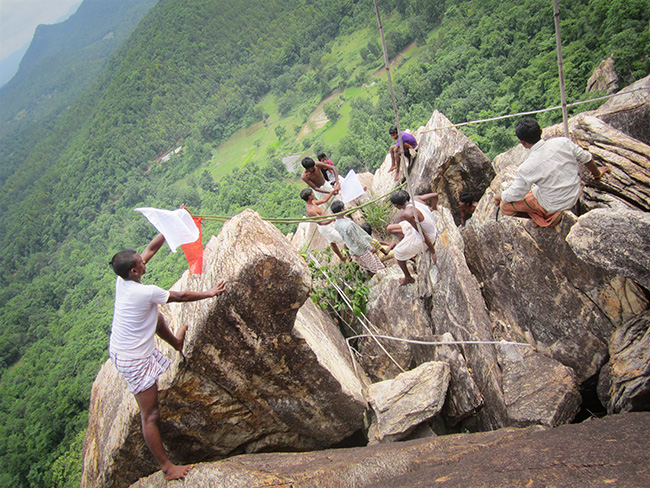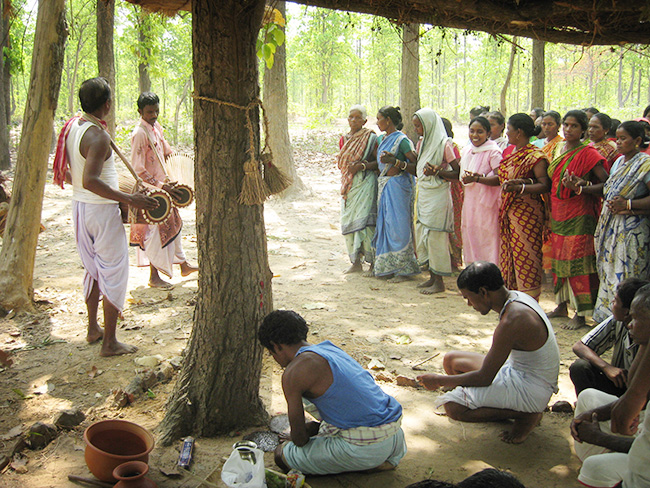The secrets of the Santal
Lea Schulte-Droesch lived for months on end among the indigenous Santal people in India. She wanted to know about their rituals and what these could tell her about their religion, social structure and relationships.
The Santal community, which consists of between 8 and 10 million people, may be large, but literature was scarce and outdated. She wanted to do field work.
She found that the forest is especially important to the Santal. It is a dangerous place, filled with ambivalent deities. However, it is essential for bringing rain at the right time
The gods from the Sacred Grove of every village, or the deities from the fields, are much more friendly. However, they all require animal sacrifice.
She was once present at a jom sim bonga ritual where as many as 40 goats were sacrificed in a ritual celebrating the place where the ancestors are said to have first cut down the forest and established the village.
Rituals like these create community, but they also connect the people to the land and their history, says Schulte-Droesch.
Reading time: 9 minutes (1,587 words)
There she was, on her very first night in the house of the Santal people in India. A house with walls made of mud, with no windows – only doors. There was a light burning all night, and another young woman was sharing her bed. Young anthropologist Lea Schulte-Droesch did not much like it, but still she had to cope. She had to keep in mind that the family she was with was trying to make her as comfortable as they could and they hated to sleep alone. They hated the dark, too: who knows what evil spirits might get to them in the night.
So she coped, because those spirits were part of why she came to these indigenous people to study. She wanted to know about their rituals and what these could tell her about their religion, social structure and relationships. She visited the Santal three times, and each time, she stayed for several months on end.
Thursday, she will be awarded her PhD on her research into what role places have within those Santal rituals.
Drums in the night
The lack of privacy was – looking back – the thing she found most difficult. The Santal had hardly any concept of individuality, she found. ‘These people are very good at being in large groups, that’s when they are most comfortable.’ The private sphere, me-time? That doesn’t exist. ‘But for me, I really needed a break sometimes’, she recalls.
Her fascination with the Santal people started when she did an internship in India with a small NGO as a student of anthropology at the University of Heidelberg. She taught English for three months in a school with mostly Santal children. ‘They came in and left by the end of the day, but I found that I didn’t really get to know them’, Schulte-Droesch says. ‘Sometimes I heard drums in the night when I lay in my bed at the school compound, but I didn’t know how they lived, or what festivals they attended.’
So when she returned home, she focused her studies on these people, who claim that their ancestors were in India long before the Hindus came.
‘It’s a big community’, Schulte-Droesch says. ‘About 8 to 10 million people. They are a mostly rural people, farmers. Their religion has many spirits, or deities that live in the forests, the sacred groves that every village has, and also ancestors living in the houses themselves.’
Hunting ritual
She found that large as the Santal community may be, literature was scarce. Most of it dated from decades ago. Often the writers hadn’t even seen what they described themselves. So when she had finished her master’s thesis, she decided to do PhD research on them – and this time, she would do fieldwork.
One hunting ritual she read about fascinated her. Every year, men would go to the forest and sacrifice animals to the hunting god. Especially interesting was the fact that trials were sometimes held in the forest, too. ‘The most serious transgressions were put before the gods so they could deal with it themselves’, Schulte-Droesch says. ‘However, the last detailed description of this court session was from the 1940s.’

So she went to Ranchi in India to first learn the language and then go in search of a ritual she did not even know still existed.
The good news: she discovered that it did. The bad news: she never actually saw it. ‘Many people told me about it. But it’s carried out in the forest and women just weren’t allowed’, she says.
Elephants and tigers
The forest is a dangerous place, according to the Santal, and no place for a woman. ‘I found it funny sometimes’, she says. ‘Those fierce men with bows and arrows were scared of the forest. Of course, there are elephants there and there used to be tigers, but it didn’t seem that dangerous to me.’
But the Santal fear the many deities that live in the forest. And these are not always friendly. ‘You never know. You need to engage in reciprocal relations with them through animal sacrifice’, she says, ‘so that they may protect you from harm and don’t send any dangerous animals your way.’
Also, they need to send the rain at the beginning of the rainy season. ‘Very important. When the rain comes too late, the seedlings may dry out and the rice harvest may fail.’ However, the gods do as they please. You never know whether the ritual will work.
The deities that live in the Sacred Grove, which every village has, are very different. A very important deity called The Big Mountain, for example. Or his wife, Mother of the Sacred Grove. You need animal sacrifices with them too, but not because they are malevolent – they protect the village and fields. But you can, of course, anger them.
Luckily for Schulte-Droesch, she saw many other rituals. Some were forbidden for women, but open to her. ‘They were proud that I wanted to learn from them and to write about them. Also, because I was a foreigner, I was allowed to witness what other women could not.’
Animal sacrifice
One thing was always present though: animal sacrifice. And lots of it. It was not easy for Schulte-Droesch to watch at first, since she gets nauseated by the sight of blood. ‘They found that funny’, she says. ‘Killing animals is so normal there. They did ask me: how do your people kill animals? And I had to say that I didn’t even know. We just buy it in the supermarket.’
She was most impressed with a special ritual only performed every ten years or so, the jom sim bonga. ‘The People of One House, a group of ‘brothers’ – or related people who are not supposed to marry – performs this’, Schulte-Droesch says. ‘I heard about it from the neighbours of one of the participants. I really wanted to see, and finally, the whole family was trying to convince this other family – that I didn’t know – to let me be present.’

Finally, she was allowed, and in the early morning, she watched the ‘brothers’ – dressed in yellow loincloths – take about 20 goat bucks (uncastrated males, ed.) to the location of the ritual, where the eldest brother, a skinny old man who seemed to be at least a hundred years old, purified the ground with a mixture of cow dung and water. He drew a circle in it with rice flower and the spice fenugreek. Other men came too – guests or an affine, people you can marry – who also bring goats, though these were castrated. A pole was put in the ground and there were coals to burn and resin that produces fragrant smoke was sprinkled on them. ‘And then they sacrificed the goats with a big axe. The heads were brought into the circle, the body left outside, after which they prostrated themselves and addressed the deity.’
‘It’s niam’
The ritual mirrored Santal social structure in the way the elder takes the lead, for example, but also in the way that the brothers relate to the guests, says Schulte-Droesch. The location of the ritual is the place where their ancestors are said to have first cut down the forest and established their first Sacred Grove. It makes them remember, but it also reinforces the ties between the ‘brothers’. ‘The pole symbolizes the brothers.’
Rituals like these create community, but they also connect the people to the land and their history, says Schulte-Droesch. Yet she realises that the Santal themselves do not think of it that way. ‘When you ask them why they do things the way they do, they just say ‘It’s niam. A sort of custom or, if you will, a way of saying, ‘that’s just the way it is’.’
Still, being able to see it, being able to gain some understanding of the way these people live, has been a great experience and a unique gift, Schulte-Droesch says. However, she was thankful when her hosts gave her her own room in the house which she could furnish. ‘I even had a bed made’, she says, ‘which I left behind for the family to use when I left.’
Too bad that worms had eaten most of it when she came back a year later, though.


